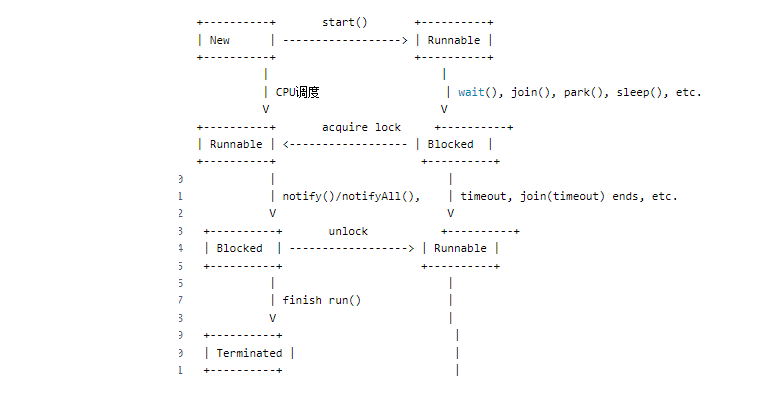Java线程
Java线程中自,类需要实现Runnable接口
import org.junit.Test;
public class TestJuc1 {
@Test
public void test1() throws InterruptedException {
Thread t1 = new Thread(new Runnable() {
@Override
public void run() {
System.out.println("hello world");
}
});
t1.start();
}
}如下图java线程Thread的实例化(初始化代码)

Thread的构造函数调用初始化方法init()
init初始化方法负责初始化thread对象相关参数
private void init(ThreadGroup g, Runnable target, String name,
long stackSize, AccessControlContext acc,
boolean inheritThreadLocals) {
if (name == null) {
throw new NullPointerException("name cannot be null");
}
this.name = name;
Thread parent = currentThread();
SecurityManager security = System.getSecurityManager();
if (g == null) {
/* Determine if it's an applet or not */
/* If there is a security manager, ask the security manager
what to do. */
if (security != null) {
g = security.getThreadGroup();
}
/* If the security doesn't have a strong opinion of the matter
use the parent thread group. */
if (g == null) {
g = parent.getThreadGroup();
}
}
/* checkAccess regardless of whether or not threadgroup is
explicitly passed in. */
g.checkAccess();
/*
* Do we have the required permissions?
*/
if (security != null) {
if (isCCLOverridden(getClass())) {
security.checkPermission(SUBCLASS_IMPLEMENTATION_PERMISSION);
}
}
g.addUnstarted();
this.group = g;
this.daemon = parent.isDaemon();
this.priority = parent.getPriority();
if (security == null || isCCLOverridden(parent.getClass()))
this.contextClassLoader = parent.getContextClassLoader();
else
this.contextClassLoader = parent.contextClassLoader;
this.inheritedAccessControlContext =
acc != null ? acc : AccessController.getContext();
this.target = target;
setPriority(priority);
if (inheritThreadLocals && parent.inheritableThreadLocals != null)
this.inheritableThreadLocals =
ThreadLocal.createInheritedMap(parent.inheritableThreadLocals);
/* Stash the specified stack size in case the VM cares */
this.stackSize = stackSize;
/* Set thread ID */
tid = nextThreadID();
}该init方法实现实例化线程Thread的参数
而Thread.start()
public synchronized void start() {
/**
* This method is not invoked for the main method thread or "system"
* group threads created/set up by the VM. Any new functionality added
* to this method in the future may have to also be added to the VM.
*
* A zero status value corresponds to state "NEW".
*/
if (threadStatus != 0)
throw new IllegalThreadStateException();
/* Notify the group that this thread is about to be started
* so that it can be added to the group's list of threads
* and the group's unstarted count can be decremented. */
group.add(this);
boolean started = false;
try {
start0();
started = true;
} finally {
try {
if (!started) {
group.threadStartFailed(this);
}
} catch (Throwable ignore) {
/* do nothing. If start0 threw a Throwable then
it will be passed up the call stack */
}
}
}启用线程的方法它调用了
/**
* 本机方法,负责实际启动当前线程。
* <p>
* 该方法被声明为私有native,意味着它是一个与平台相关的本机方法,具体实现位于JVM中。
* 它的目的是开始当前线程的执行,这是线程生命周期中的第一步。
* 由于该方法的实现依赖于特定的平台(例如,Windows或Linux上的线程启动机制不同),
* 因此它被声明为native,其具体实现由JVM提供。
* <p>
* 方法名中的"0"后缀是一种常见的命名惯例,用于表示本机方法,它没有实际的语义含义。
* 它的使用是为了与Java的JNI(Java Native Interface)机制保持一致,该机制要求本机方法具有特定的命名模式。
* <p>
* 注意:该方法没有参数和返回值,因为它的目的只是启动线程,不需要传递任何信息或期望获得任何结果。
*/
private native void start0();
/**
* 当线程被激活时,此方法将被执行。该方法的目的是执行特定的任务或操作。
* 本方法的实现决定了线程的具体行为。
*/
public void run() {
// 在这里编写执行线程任务的代码
}Java中的Thread类提供了丰富的API来创建、管理和控制线程。以下是一些常用方法及其用途:
start():
用途: 启动线程并执行其run()方法。调用此方法后,线程进入可运行状态(Runnable)。
run():
用途: 定义线程要执行的任务。通常需要重写此方法以包含自定义的逻辑。
currentThread()(静态方法):
用途: 返回当前正在执行的线程对象的引用,常用于获取当前线程的信息。
getName() 和 setName(String name):
用途: 分别用于获取和设置线程的名称,有助于调试和监控。
join():
用途: 当前线程等待调用此方法的线程结束。可以带参数指定等待时间。
sleep(long millis):
用途: 强制当前正在执行的线程暂停执行指定的毫秒数,使线程进入限时等待状态。
yield():
用途: 让出CPU执行权,使当前线程从运行状态变为可运行状态,让其他相同优先级的线程有机会执行。但这不是一个强制性的操作,实际行为依赖于操作系统的线程调度策略。
isAlive():
用途: 判断线程是否还在执行,即是否已启动且尚未死亡。
interrupt():
用途: 中断线程。设置线程的中断标志位,通常用于取消线程的阻塞状态,如从
wait(),join(), 或sleep()方法中提前返回。
isInterrupted():
用途: 测试线程是否被中断,不改变中断状态。
interrupted() (静态方法):
用途: 测试当前线程是否被中断,并清除中断状态。
getState():
用途: 获取线程当前的状态,返回的是
Thread.State枚举值。
setPriority(int newPriority):
用途: 设置线程的优先级,范围在MIN_PRIORITY(1)到MAX_PRIORITY(10)之间,默认为NORM_PRIORITY(5)。
getPriority():
用途: 获取线程的优先级。
wait(),wait(long timeout),wait(long timeout, int nanos):
用途: 使当前线程等待,直到另一个线程调用此对象的**notify()或notifyAll()**方法,或者超过指定的等待时间。这些方法必须在同步上下文中使用。
notify() 和notifyAll():
用途: 唤醒在此对象监视器上等待的一个或所有线程。同样,这些方法应在同步代码块或方法中调用。
它的流程
